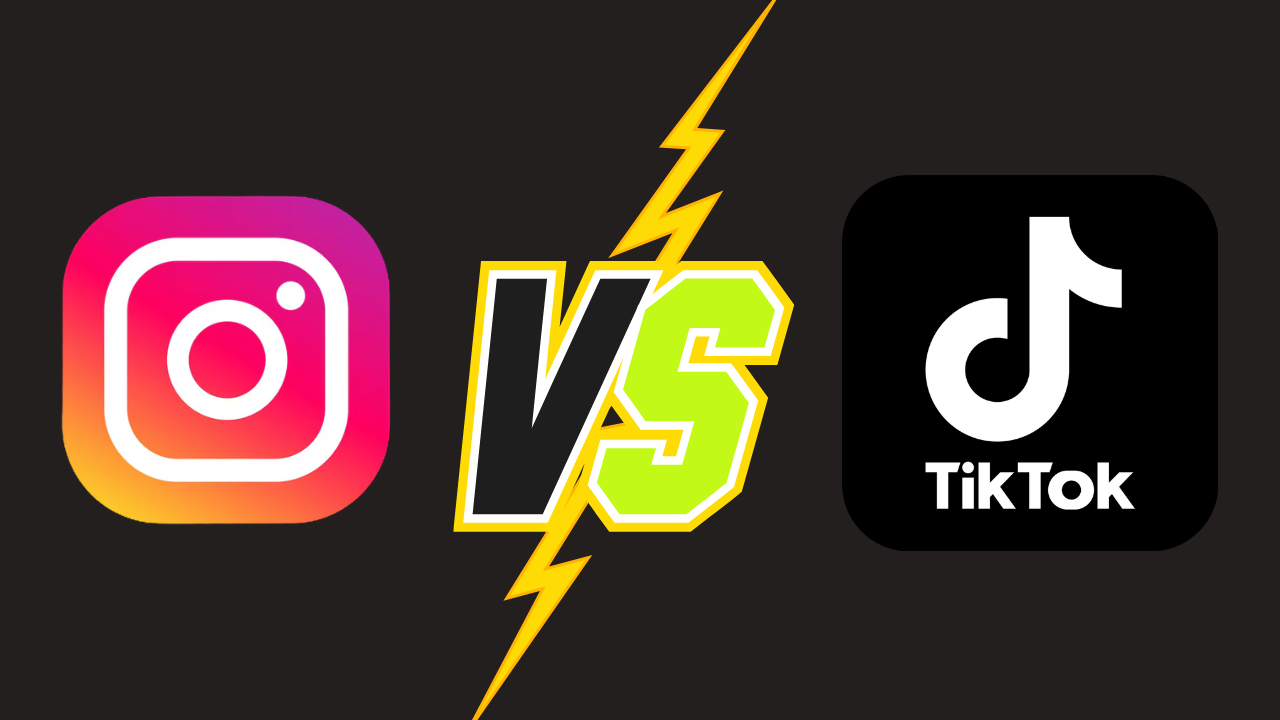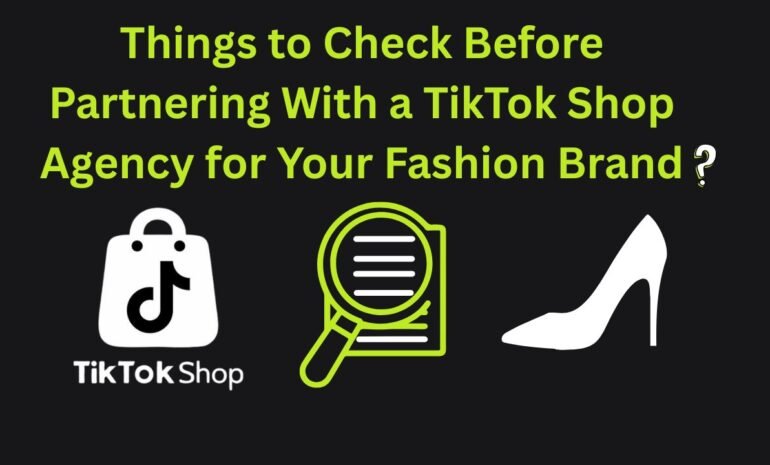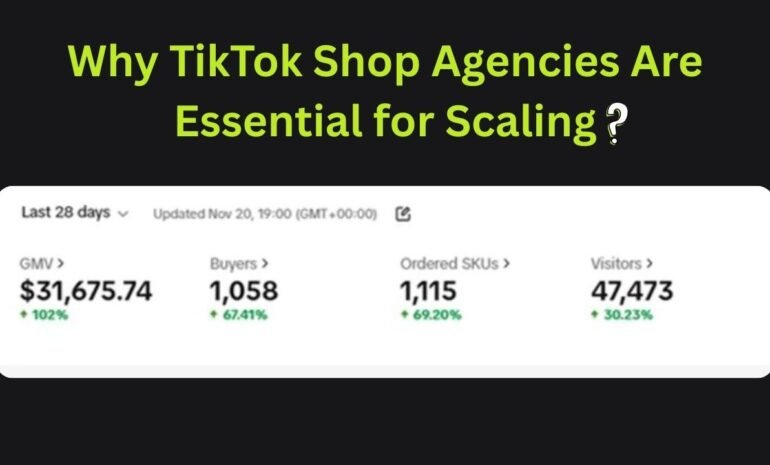Have you ever wondered why big brands choose premium spots for their stores?
The reason is simple: location matters. It plays a major role in reaching the right customers.
In the online world, picking the right platform works the same way. In 2023, global social commerce sales reached $992 billion, and forecasts show they could nearly double to $1.99 trillion by 2026.
For years, Instagram has been a favorite for sellers wanting to sell online. Its visually driven interface, high user engagement, and integrated shopping tools make it easy for brands to showcase products.
However, in recent years, TikTok has risen as a powerful social commerce platform with its in-app TikTok Shop. What started as an app for viral trends and dance videos has now become a space where entertainment meets shopping.
If you’re an online seller deciding between TikTok vs Instagram, this blog will help. We’ll compare both platforms across important factors so you can decide where to focus your online selling efforts.
So, let’s begin.
TikTok vs Instagram: Platform Overview
Before you choose between TikTok and Instagram, here is an overview of each platform. This will help you understand their distinct philosophies that shape brand and creator engagement.
TikTok – Fast, Fun, and Viral
TikTok is all about short, snappy videos that grab attention instantly. Your feed (the For You Page) is a never-ending scroll of fresh, entertaining content. From funny skits to trending challenges, and catchy sounds, TikTok offers raw, real, and super engaging content. Therefore, it is easy for anyone to go viral, even with simple videos.
Brands love TikTok for its trend-driven growth and massive reach without needing fancy production. Shopping here feels like part of the fun, impulse buys happen naturally!
Instagram – Polished, Versatile, and Community-Focused
Instagram is your go-to for beautiful, curated content, whether it’s Reels, photos, Stories, or Live videos. It’s perfect for brands that want to tell a story, showcase a lifestyle, or sell with a premium vibe.
Unlike TikTok, Instagram values high-quality visuals and deeper connections with followers. Shopping here feels sleek and intentional, with smooth product discovery and a more aspirational feel.
The main difference lies in content approach: TikTok prioritizes discovery and viral reach independent of follower count, while Instagram centers on community and curated brand narratives.
TikTok’s shopping feels organic and entertainment-driven, encouraging impulse purchases, whereas Instagram offers a more refined, premium shopping journey.
Audience Landscape
No matter how good your product or service is, selling it in the wrong market can limit your results. Choosing the right market is crucial for success, and understanding your audience plays a key role in any effective marketing strategy.
TikTok and Instagram both have huge global reach, but their users differ widely in scale, growth, demographics, and engagement habits.
TikTok: Rapid Growth and a Youth-Centric Audience
TikTok provides brands with a chance to get viral and earn rapid growth. The platform’s audience is mainly youth including millennials and Gen Z. Here are the details.
Global Reach and Growth
TikTok’s growth has been remarkable. In 2025, its monthly active users increased by 12%, exceeding 1.8 billion worldwide. In the last five years, it added over 1.3 billion users, growing by 216%.

User Demographics: Age and Gender
TikTok’s audience is mostly young. About 70% of users are between 18 and 35, and over 60% are aged 13 to 24.
Gen Z adoption is very high, with 82% active on TikTok. The largest age group varies depending on the source, either 18-24 or 25-34 years.
The gender balance has shifted to almost even, with about 55-56% male users in 2025, expanding TikTok’s appeal beyond its earlier mostly female audience.
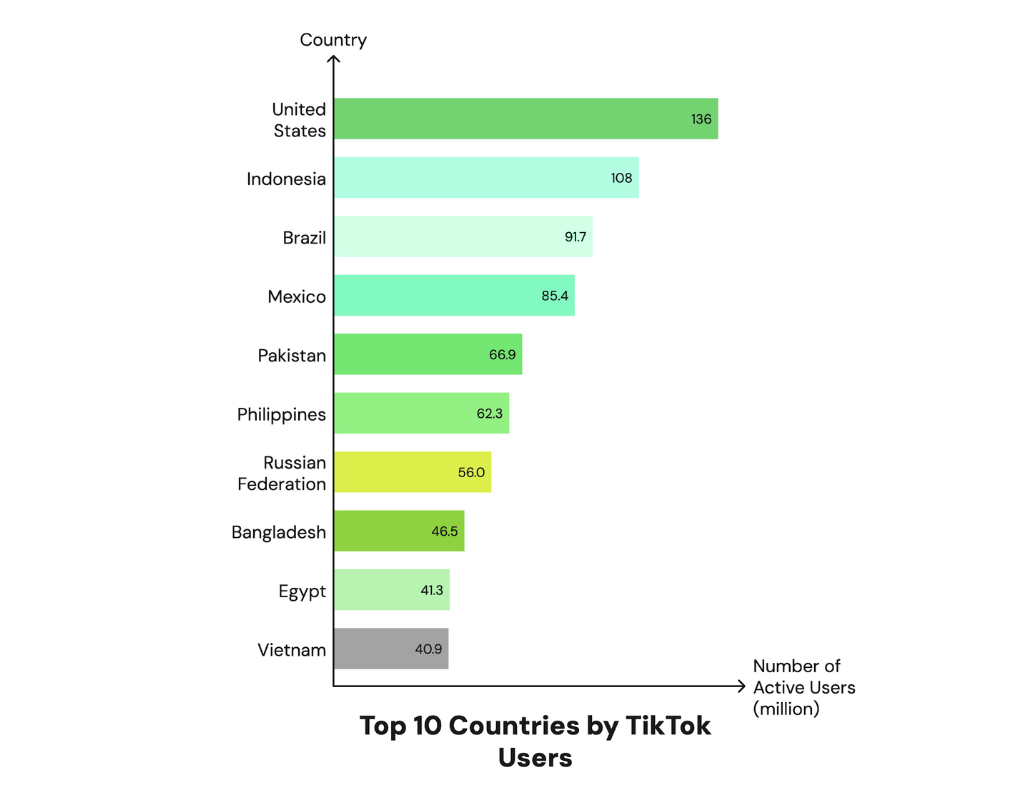
Engagement and Usage Habits
Users spend around 95 minutes daily on TikTok. Each user opens the app about 19 times each day.
On average, they watch 265 videos daily. The platform is mainly used for entertainment and discovery. 77% of Gen Z use TikTok to find products, and 63% use it for suggestions from influencers/news
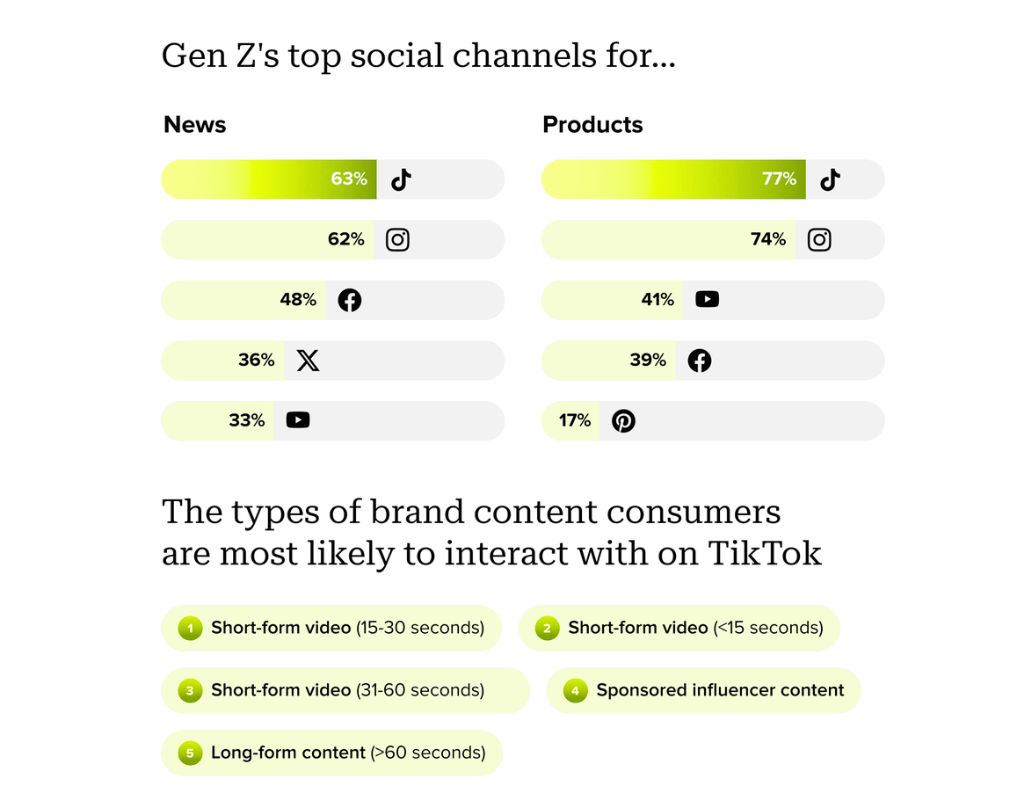
Its design encourages quick, immersive video viewing, which often leads to impulse purchases through fun and organic content.
What This Means for Brands
TikTok is great for brands that want to reach young people who follow trends and enjoy viral content. It’s also important for businesses looking to grow quickly and reach new audiences, especially in fast-growing markets. The main thing is to make short, fun videos that match TikTok’s style and how its algorithm works.
Instagram: Mature Reach with Broad Demographics and Strong Engagement
Instagram’s wide user base offers valuable opportunities for brands to engage deeply with customers. Here’s why
Global Reach and Growth
Instagram is one the leading social media platforms, with around 2 billion monthly active users, and some estimates reaching up to 2.42 billion. It ranks as the third most popular network worldwide.

Although its growth rate is slower than TikTok’s, about 7.2% from 2024 to 2025, it still gained 110 million new users in 2025. It’s definitely a large and steady number, specifically in well-established markets.
Instagram has a strong presence in India (414 million users), the U.S. (172 million), and Brazil (141 million). Growth in Europe is steady but has started to level off. This mature market reach benefits brands that are focused on long-term engagement and customer loyalty.
Demographics: Age and Gender
Instagram’s audience is broader and slightly older compared to TikTok’s. Around 60% of users are under 35. With the largest age group between 18 and 24 (about 31.7%), though many also highlight the 25-34 range.
The gender split is fairly balanced. Males make up around 50.6% to 53% and females between 47% and 49.4%. This mix makes Instagram a good choice for brands targeting both Millennials and Gen Z.

User Engagement
Users spend an average of 49 to 62 minutes daily on Instagram. They open the app about 6 to 7 times per day. They watch fewer videos compared to TikTok that’s around 177 daily but Instagram excels in inspiring purchases and encouraging brand interactions.
About 61% of users look for product ideas, 69% find brand content engaging, and 50% interact with brands daily. It’s also a key platform for customer support, with 72% of Gen Z using Instagram to communicate with brands.
Brand Opportunities
Instagram provides brands with a chance to build lasting relationships through varied content types like Feed posts, Stories, Reels, and direct messages.
It works well for lifestyle branding, detailed storytelling, and maintaining steady engagement with a balanced and established audience.
TikTok vs Instagram: Comparative Audience Demographics & Usage (2024-2025)
|
Metric |
TikTok |
|
|---|---|---|
|
Monthly Active Users (Global) |
~1.6B – 2B |
~2B – 2.42B |
|
User Growth (YoY 2024-2025) |
+18.4% |
+7.2% |
|
Largest Age Group |
25-34 (35.3%) or 18-24 (36.2-38.5%) |
18-24 (31.7%) or 25-34 |
|
% Gen Z with Account |
82% |
N/A (but strong Gen Z favorite) |
|
Gender Distribution (Male:Female) |
~55.7%:44.3% |
~50.6%:49.4% |
|
Average Daily Time Spent |
~95 min |
~62 min |
|
Primary User Intent |
Entertainment, Product Discovery, Impulse Buys |
Purchase Inspiration, Connection, Entertainment, Customer Care |
|
Key Geographic Strengths |
US, Indonesia, Brazil, Asia |
India, US, Brazil, Europe |
|
Gen Z for Product Discovery |
77% |
61% |
Content Dynamics and Algorithmic Mastery
To maximize reach, engagement and conversions, it is important to understand how these platforms deliver and promote content. Their formats and algorithms work very differently, so brands need to use different strategies for each platform.
TikTok
TikTok is all about short videos and viral discovery.
Content Style
TikTok focuses on short vertical videos, usually between 15 seconds and 3 minutes. Longer videos are also becoming popular. The content is raw, real, and often fun. Things like humor, challenges, trending music, and effects are common. TikTok rewards quick creativity and encourages users to join in with challenges and remixes.
Unlike Instagram, TikTok prefers content that feels natural instead of overly polished. This lowers production costs and lets brands quickly jump on new trends. It’s perfect for brands that want to create fast, authentic videos that catch attention.
How the Algorithm Works: The “For You Page” (FYP)
TikTok’s algorithm helps users discover new content using factors like how many people watch videos all the way through, replays, likes, shares, and popular sounds. Videos that are watched again get more visibility.
The algorithm shows videos even to people who don’t follow the creator that helps content go viral. According to Influencer Marketing, In 2025, the average TikTok video engagement ranges from 2.88% to 7.50% depending on follower count
Tips for Brands
To succeed on TikTok, you should grab attention in the first three seconds, encourage people to watch the whole video, add subtitles, post often (1-4 times a day), and interact with comments and other creators. Using trending sounds and sticking to a specific niche also helps reach more viewers.
If you are a brand and want to connect with the creators, contact us. We help you find the right influencers that understand your brand and align with your goals to increase conversions.
What This Means for Brands
TikTok works best for brands that want quick growth, viral campaigns, and to reach younger audiences. Its easy-to-make content style supports frequent posting and community trends. Smaller influencers often get great reach that makes TikTok a cost-effective way to raise brand awareness. Brands should focus on real, entertaining, and timely videos designed for fast watching and discovery.
Instagram is a platform of diverse formats and works on relationship-driven algorithm.Let’s understand how
Content Formats and Aesthetic
Instagram offers many ways to share content including reels (short videos up to 3 minutes), regular photos, multi-photo carousels, longer videos (up to 60 minutes), Stories with interactive features, Live broadcasts, Broadcast Channels, and text updates called Notes.
The platform focuses on polished, carefully planned visuals that appeal to lifestyle and luxury brands. Static photos are still very popular, and creating content here usually requires more creativity and higher production effort than TikTok.
How Instagram’s Algorithm Works: Feed, Explore, and Reels
Instagram shows content based on how users interact with posts such as likes, comments, shares, saves and also considers how popular the post is and how much users engage with the account. The Feed mostly shows posts from people you follow, while the Explore page and Reels help users find new content.
Unlike TikTok, Instagram’s Explore page prefers popular posts and creators who are already known to the user’s network. This makes it harder for new creators to get viral without a strong following. Sharing posts through direct messages helps improve visibility on Explore.
How to Go Viral on Instagram
To get viral on Instagram, you need strong engagement from your followers early on. For Reels, brands should quickly post follow-up videos after a viral hit, use eye-catching visuals (especially for viewers who watch without sound), avoid videos with watermarks from other apps, and keep videos between 30 and 90 seconds. Building steady momentum within your existing community is very important. However, the engagement rate on Instagram in 2025 is less than TikTok 1.77% to 3.65% depending on follower count.
What This Means for Brands
Instagram works well for brands focused on building long-term connections, telling detailed lifestyle stories, and keeping a polished brand image. The variety of content types lets brands share stories in different ways, but it requires regular, high-quality content.
Partnerships with influencers on Instagram often lead to steady sales because of loyal followers, making it a good platform for brands targeting thoughtful buyers and customer loyalty.

TikTok vs Instagram: Algorithmic Drivers for Content Visibility & Engagement
|
Metric |
TikTok Algorithm |
Instagram Algorithm (Reels/Feed/Explore) |
|---|---|---|
|
Primary Goal |
Discoverability, Virality, User Retention |
Relationship Building, Community Engagement, Views |
|
Key Engagement Signals |
Video Completion, Replays, Shares, Comments, Likes, Follows |
Likes, Comments, Shares, Saves, DMs, Views |
|
Content Preference |
Short-form, Authentic, Trend-driven, Audio-centric, Raw/Unpolished |
Polished Visuals, Diverse Formats (Reels, Photos, Carousels, Stories), Aesthetic-focused, Brand Storytelling |
|
Virality Potential |
High, easier for new creators/small accounts |
Lower, relies on existing audience push/popularity |
|
Average Impressions per Post (2025) |
~6268 |
~2635 |
|
Recommended Posting Frequency |
1-4x/day (ideally 3x/day) |
Consistent, quality over quantity |
|
Importance of Trending Audio |
High |
High for Reels/Stories |
|
Content to Avoid |
N/A (focus on native feel) |
Watermarks from other apps |
Social Commerce: Converting Engagement into Sales
Both TikTok and Instagram have changed social media into strong places for shopping, but they do it in different ways. Knowing these differences can help brands sell better by using the right strategies.
TikTok Shop- Seamless Shopping Experience
TikTok’s shopping feature is built right into its “For You” feed. This makes it easy and natural for users to discover products. Videos have product tags, so people can buy without leaving the app. This smooth experience fits well with TikTok’s focus on fun and entertainment.
Read our guide on how to start TikTok Shop to learn more.
Live Shopping: Real-Time Interaction
Live shopping on TikTok lets brands interact with viewers in real time, great for flash sales or limited offers that create excitement.
Algorithm Boosts for Shoppable Content
TikTok’s algorithm promotes products that match users’ interests, helping videos go viral. Brands can also use dynamic ads based on past browsing, and Spark Ads to boost organic content.
Shopify Integration and Availability
Currently, TikTok Shopping supports business accounts and integrates with Shopify in the U.S., UK, and Canada, making it easy to set up storefronts and tag products in videos.
Conversion Rates and Return on Ad Spend (ROAS)
These metrics show how well your ads turn viewers into buyers and how much revenue you earn for every dollar spent on advertising.
High Purchase Likelihood on TikTok
Users are 1.7 times more likely to buy through TikTok than other platforms, with huge views on trending shopping hashtags.
Cost-Effectiveness for Ads
The average cost per click is lower on TikTok compared to Instagram, making it attractive for brands, especially for impulse and trend-led purchases.
Strong Results in Key Categories
Fashion, beauty, and homeware brands often see double the return on ad spend on TikTok compared to other channels.
Impulse Buying Driven by Content
TikTok’s fun, viral videos and influencer endorsements encourage quick buying decisions, with over half of users making spontaneous purchases.
Seller Tools and Fees
Here are details for seller tools and fee on the TikTok.
Referral and Transaction Fees
TikTok charges a 6% referral fee per order, plus transaction fees updated as of 2025
Commission Rates by Category
Commissions start at 1.8% for new sellers and can increase up to about 8%, depending on product type.
Seller Responsibilities
Sellers handle refunds, returns, and shipping costs themselves.
Creating engaging shoppable videos and using promotional features effectively while managing fees is essential.
Instagram Shopping: Organized and Aspirational Experience
Here’s what you get on Instagram when you sell on this platform.
Features and User Experience
Instagram Shopping gives users a well-organized way to shop. Products can be tagged in photos, Stories, Reels, and through the dedicated “Shop” tab. You can create neat storefronts that show lifestyle-focused content.
Product details come straight from brand catalogs, and users can buy either inside the app or by visiting the brand’s website. Instagram focuses on high-quality images and polished videos.
Its personalized shopping tab helps users find recommended products. Thanks to its connection with Facebook’s marketplace and ad system, brands can easily expand their reach across both platforms.
Conversion Rates and ROAS
Instagram Reels ads have a slightly lower engagement rate than TikTok (5.2% vs. 6.8%) but deliver 1.3 times better conversion rates for e-commerce. Instagram users tend to be more ready to buy, especially for bigger purchases like furniture and tech.
The smooth “Shop Now” buttons and an older, established audience help generate high-quality leads and strong sales.
While TikTok reports a 32% higher ROAS overall in early 2025, Instagram still leads in premium product categories and retargeting with its Facebook integration. Instagram Reels Shopping works well for brands with loyal communities and allows better retargeting and deeper customer engagement.
Seller Tools and Fees
Instagram offers many tools to help sellers, including shopping features and affiliate marketing options. Brands can link their online stores to their profiles or Reels for easy checkout. Creators can use business or creator accounts linked to Facebook catalogs and use Product Tags, Link Stickers, and Creator Shops.
Affiliate marketing on Instagram boosts sales with unique links and promo codes shared through Stories, Reels, Lives, and Carousels. Instagram is known for good influencer marketing results, with dashboards that track clicks, conversions, and order values. Its advanced ad system helps brands scale and measure their campaigns effectively.
Influencer and Creator Ecosystems
Both TikTok and Instagram rely heavily on creators and influencers, but each platform has its own way of helping them earn money and work with brands. Knowing these differences helps brands create better partnerships.
Creator Monetization Programs
Creator Monetization Programs explain how TikTok and Instagram help creators earn money through different reward and bonus systems.
TikTok Creator Rewards Program
TikTok replaced its old Creator Fund with the new Creator Rewards Program in late 2023. Now, creators can earn much more between $0.40 and $1.00 or more per 1,000 views, which is up to 20 times higher than before.
To join, creators need to be at least 18 years old, have 10,000 followers, get 100,000 views in the past 30 days, and make videos that are at least one minute long.
This encourages creators to produce longer and more engaging videos instead of just short clips.
Instagram Reels Bonus Program
Instagram pays creators and businesses through the Reels Bonus Program. To qualify, they need at least 5 million views on Reels in the last three months. The bonus depends on views, who watches, and engagement. Instagram has strict rules and doesn’t pay for static images, slideshows, or looping videos.
Brand Partnership Platforms
For businesses looking to connect with the right influencers, TikTok Creator Marketplace offers a streamlined way to discover and collaborate with creators who align with their brand goals.
TikTok Creator Marketplace (TTCM)
TikTok’s Creator Marketplace serves as the primary hub for brand-creator collaborations. It allows brands to find influencers based on location, category, follower count, and engagement.
The platform supports campaign management and real-time analytics, with payment processing handled securely within the app. Creators typically need 10,000 followers, 100,000 likes in 28 days, and be 18 or older to join. TTCM simplifies partnership discovery and boosts transparency for both parties.
If you’re a TikTok Shop creator seeking brand collaborations, reach out to us to connect with top brands for affiliate marketing opportunities.
Instagram Creator Marketplace
Instagram’s Creator Marketplace is accessed through Meta Business Suite for brands and the professional dashboard within Instagram for creators. It helps brands find creators who fit their audience and campaign goals, reducing cold outreach efforts.
Creators can activate branded content tools and disclose paid partnerships across all formats. While Instagram facilitates communication, creators and brands negotiate terms and payments directly.
Influencer Pricing and Return on Investment (ROI)
Understanding influencer pricing and measuring return on investment is essential for making informed decisions in any TikTok marketing campaign.
TikTok Influencer Pricing and ROI
TikTok influencers generally charge less, making it attractive for budget-conscious campaigns focusing on viral engagement. Pricing ranges for TikTok influencers in 2025 are roughly:
- Nano (1K–10K followers): $5–$50
- Micro (10K–100K): $50–$800
- Macro (100K–500K): $300–$4,000
- Mega (500K–1M): $1,500–$8,000
- Celebrity (1M+): $8,000+
TikTok offers higher ROI for brands targeting younger demographics, thanks to its algorithm that boosts content discovery beyond follower count. Its engagement rate is 5.3%, more than double Instagram’s 2.4%.
This allows smaller creators to rapidly grow influence, providing cost-effective broad awareness and authentic connection.
Instagram Influencer Pricing and ROI
Instagram influencers typically command higher fees:
- Nano: $10–$100
- Micro: $100–$1,000
- Macro: $500–$5,000
- Mega: $2,000–$10,000
- Celebrity: $10,000+
Instagram suits brands focused on long-term relationships and loyalty, especially in fashion, beauty, home decor, and luxury sectors where visual storytelling is key. Its polished content and features like shopping enhance sales-driven campaigns.
Instagram’s strengths lie in stable community building and influencer partnerships that nurture lasting brand trust.
A Combined Approach: Making the Most of Both Platforms
Using TikTok and Instagram together can give your brand the best of both worlds. Here’s how you can combine their strengths effectively:
Use TikTok for quick brand awareness and viral moments.
Focus on creating short, authentic, and engaging videos that capture attention fast. Take advantage of TikTok’s algorithm to reach new audiences and spark impulse buys through fun, trend-driven content.
Leverage Instagram for deeper storytelling and customer loyalty
Share polished visuals, lifestyle stories, and detailed product highlights. Use Instagram’s shopping features and influencer partnerships to build long-term relationships and drive higher-value sales.
Cross-promote content
Repurpose TikTok videos as Instagram Reels or Stories with some tweaks for the Instagram audience. Similarly, use Instagram content ideas to inspire TikTok creativity.
Tailor your ads and campaigns for each platform.
TikTok ads can focus on trends and viral potential, while Instagram ads can emphasize brand values and customer engagement.
By combining TikTok’s energy and reach with Instagram’s sophistication and engagement, you create a balanced strategy that drives both fast growth and lasting brand loyalty.
Conclusion
If you’re a brand wondering about TikTok vs Instagram, both platforms offer unique strengths but work differently. TikTok is ideal for creating quick buzz, reaching a younger audience, and driving impulse buys with fun, authentic videos. It’s focused on fast, viral moments that catch attention instantly.
Instagram, on the other hand, helps you build deeper connections with a broader, slightly older audience. It’s perfect for sharing your brand story, posting polished content, and turning followers into loyal customers through strong shopping tools and influencer partnerships.
The best approach for TikTok vs Instagram is to use TikTok to spark excitement and boost immediate sales, then rely on Instagram to keep your audience engaged and build long-term growth. Tailoring your content to each platform’s style will help you get the most from both.
Ready to Grow on TikTok Shop?
Let our agency take care of it all, from product research and account creation to influencer partnerships and ad campaigns. Book your 1:1 TikTok Shop consultation today and get your first campaign off the ground fast!
FAQs
1. Which platform is better for online sellers, TikTok or Instagram?
It depends on your target audience and goals. TikTok is great for reaching younger buyers with viral, impulse-driven shopping. Instagram suits brands aiming for polished visuals, long-term customer engagement, and premium sales.
2. How do TikTok and Instagram differ in shopping features?
TikTok integrates shopping directly in videos with a focus on entertainment and impulse buys, while Instagram offers curated storefronts with a more structured, aspirational shopping experience.
3. What are the main audience differences between TikTok and Instagram?
TikTok attracts a younger, trend-focused crowd spending more time on short videos. Instagram has a broader age range with users engaging more deeply with brands through diverse content formats.
4. Are influencer marketing costs different on TikTok and Instagram?
Yes. TikTok influencers tend to charge less and offer higher engagement for viral content, while Instagram influencers command higher fees focused on polished storytelling and loyalty.

